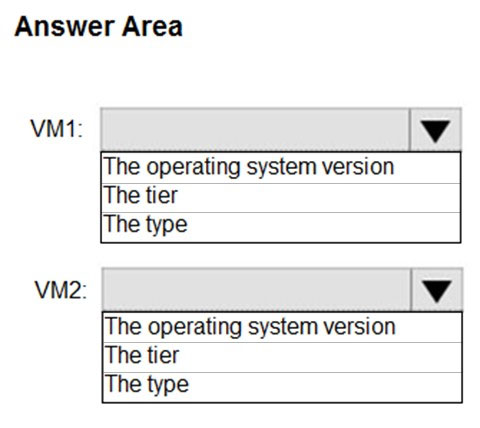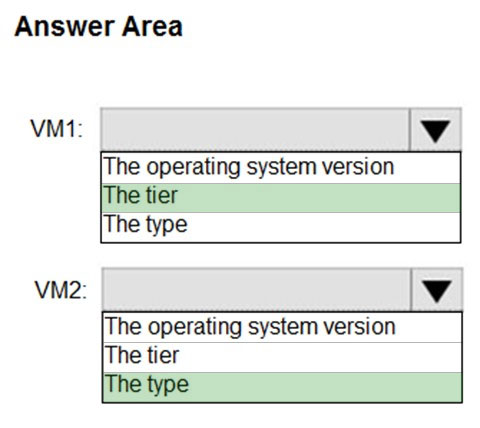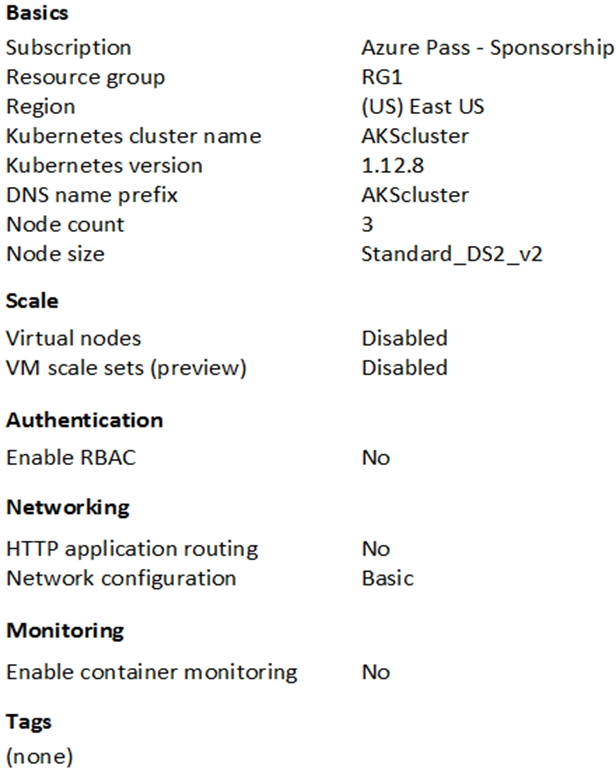You have Azure Resource Manager templates that you use to deploy Azure virtual machines.
You need to disable unused Windows features automatically as instances of the virtual machines are provisioned.
What should you use?
Answer:
B
You can use Azure Automation State Configuration to manage Azure VMs (both Classic and Resource Manager), on-premises VMs, Linux machines, AWS VMs, and on-premises physical machines. Note: Azure Automation State Configuration provides a DSC pull server similar to the Windows Feature DSC Service so that target nodes automatically receive configurations, conform to the desired state, and report back on their compliance. The built-in pull server in Azure Automation eliminates the need to set up and maintain your own pull server. Azure Automation can target virtual or physical Windows or Linux machines, in the cloud or on- premises.
You have an Azure Container Registry named Registry1.
From Azure Security Center, you enable Azure Container Registry vulnerability scanning of the images in Registry1.
You perform the following actions:
✑ Push a Windows image named Image1 to Registry1.
✑ Push a Linux image named Image2 to Registry1.
✑ Push a Windows image named Image3 to Registry1.
✑ Modify Image1 and push the new image as Image4 to Registry1.
Modify Image2 and push the new image as Image5 to Registry1.
Which two images will be scanned for vulnerabilities? Each correct answer presents a complete solution.
NOTE: Each correct selection is worth one point.
Answer:
BE
Only Linux images are scanned. Windows images are not scanned.
Reference:
https://docs.microsoft.com/en-us/azure/security-center/azure-container-registry-integration
HOTSPOT -
You have two Azure virtual machines in the East US 2 region as shown in the following table.
You deploy and configure an Azure Key vault.
You need to ensure that you can enable Azure Disk Encryption on VM1 and VM2.
What should you modify on each virtual machine? To answer, select the appropriate options in the answer area.
NOTE: Each correct selection is worth one point.
Hot Area:
Answer:

VM1: The Tier -
The Tier needs to be upgraded to standard.
Disk Encryption for Windows and Linux IaaS VMs is in General Availability in all Azure public regions and Azure Government regions for Standard VMs and VMs with Azure Premium Storage.
VM2: The type -
Need to change the VMtype to any of A, D, DS, G, GS, F, and so on, series IaaS VMs.
Not the operating system version: Ubuntu 16.04 is supported.
References:
https://docs.microsoft.com/en-us/azure/security/azure-security-disk-encryption-overview https://docs.microsoft.com/en-us/azure/security/azure-security-disk-encryption-faq#bkmk_LinuxOSSupport
You have the Azure virtual machines shown in the following table.
You create an Azure Log Analytics workspace named Analytics1 in RG1 in the East US region.
Which virtual machines can be enrolled in Analytics1?
Answer:
A
Note: Create a workspace -
✑ In the Azure portal, click All services. In the list of resources, type Log Analytics. As you begin typing, the list filters based on your input. Select Log Analytics.
Click Create, and then select choices for the following items:
Provide a name for the new Log Analytics workspace, such as DefaultLAWorkspace. OMS workspaces are now referred to as Log Analytics workspaces.
Select a Subscription to link to by selecting from the drop-down list if the default selected is not appropriate.
For Resource Group, select an existing resource group that contains one or more Azure virtual machines.
Select the Location your VMs are deployed to. For additional information, see which regions Log Analytics is available in.
Incorrect Answers:
B, C: A Log Analytics workspace provides a geographic location for data storage. VM2 and VM3 are at a different location.
D: VM4 is a different resource group.
References:
https://docs.microsoft.com/en-us/azure/azure-monitor/platform/manage-access
You are testing an Azure Kubernetes Service (AKS) cluster. The cluster is configured as shown in the exhibit. (Click the Exhibit tab.)
You plan to deploy the cluster to production. You disable HTTP application routing.
You need to implement application routing that will provide reverse proxy and TLS termination for AKS services by using a single IP address.
What should you do?
Answer:
A
An ingress controller is a piece of software that provides reverse proxy, configurable traffic routing, and TLS termination for Kubernetes services.
Reference:
https://docs.microsoft.com/en-us/azure/aks/ingress-tls
Note: This question is part of a series of questions that present the same scenario. Each question in the series contains a unique solution that might meet the stated goals. Some question sets might have more than one correct solution, while others might not have a correct solution.
After you answer a question in this section, you will NOT be able to return to it. As a result, these questions will not appear in the review screen.
You have an Azure subscription. The subscription contains 50 virtual machines that run Windows Server 2012 R2 or Windows Server 2016.
You need to deploy Microsoft Antimalware to the virtual machines.
Solution: You add an extension to each virtual machine.
Does this meet the goal?
Answer:
A
You can use Visual Studio to enable and configure the Microsoft Antimalware service. This entails selecting Microsoft Antimalware extension from the dropdown list under Installed Extensions and click Add to configure with default antimalware configuration.
References:
https://docs.microsoft.com/en-us/azure/security/fundamentals/antimalware
Note: This question is part of a series of questions that present the same scenario. Each question in the series contains a unique solution that might meet the stated goals. Some question sets might have more than one correct solution, while others might not have a correct solution.
After you answer a question in this section, you will NOT be able to return to it. As a result, these questions will not appear in the review screen.
You have an Azure subscription. The subscription contains 50 virtual machines that run Windows Server 2012 R2 or Windows Server 2016.
You need to deploy Microsoft Antimalware to the virtual machines.
Solution: You connect to each virtual machine and add a Windows feature.
Does this meet the goal?
Answer:
B
Microsoft Antimalware is deployed as an extension and not a feature.
Reference:
https://docs.microsoft.com/en-us/azure/security/fundamentals/antimalware
You have an Azure Active Directory (Azure AD) tenant named Contoso.com and an Azure Kubernetes Service (AKS) cluster AKS1.
You discover that AKS1 cannot be accessed by using accounts from Contoso.com.
You need to ensure AKS1 can be accessed by using accounts from Contoso.com. The solution must minimize administrative effort.
What should you do first?
Answer:
A
Reference:
https://docs.microsoft.com/en-us/azure/aks/azure-ad-integration-cli
You have an Azure subscription that contains an Azure Container Registry named Registry1. Microsoft Defender for Cloud is enabled in the subscription.
You upload several container images to Registry1.
You discover that vulnerability security scans were not performed.
You need to ensure that the container images are scanned for vulnerabilities when they are uploaded to Registry1.
What should you do?
Answer:
A
Reference:
https://charbelnemnom.com/scan-container-images-in-azure-container-registry-with-azure-security-center/
From Azure Security Center, you create a custom alert rule.
You need to configure which users will receive an email message when the alert is triggered.
What should you do?
Answer:
A
Reference:
https://docs.microsoft.com/en-us/azure/azure-monitor/platform/action-groups